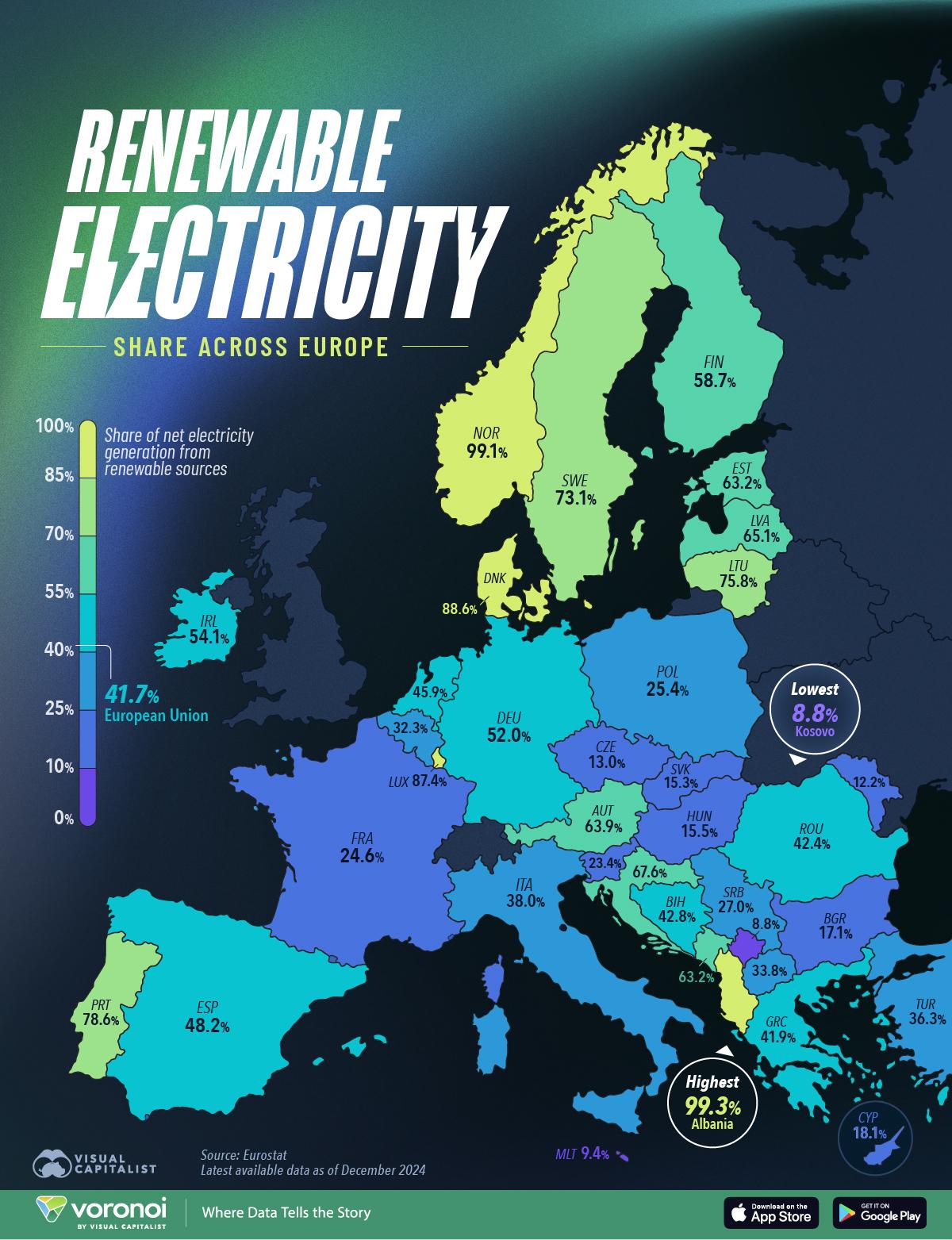Renewable Electricity Share Across Europe Map


Alex Cartwright
Senior Cartographer & GIS Specialist
Alex Cartwright is a renowned cartographer and geographic information systems specialist with over 15 years of experience in spatial analysis and data...
Geographic Analysis
What This Map Shows
The "Renewable Electricity’s Share Across Europe" map illustrates the percentage of electricity generated from renewable sources—such as wind, solar, hydro, and biomass—across various European countries. Each country is color-coded to reflect its proportion of renewable energy in the overall electricity mix, providing a visual representation of how committed each nation is to sustainable energy practices. This map serves as a crucial tool for understanding the current landscape of renewable energy in Europe and highlights both the leaders and laggards in this vital sector.
Deep Dive into Renewable Energy in Europe
Renewable energy has become a focal point in the global fight against climate change, and Europe is at the forefront of this transition. As of 2023, many European nations are investing heavily in renewable technologies to decrease their reliance on fossil fuels and reduce greenhouse gas emissions. Interestingly, the European Union has set a target to become climate-neutral by 2050, aiming to drastically increase the share of renewables in its energy mix.
Wind energy stands out as one of the leading contributors to renewable electricity across Europe. Countries like Denmark and Germany have made significant strides in this area, with Denmark generating about 47% of its electricity from wind power in recent years. In fact, Denmark has even set ambitious goals to achieve 100% renewable energy by 2050, showcasing what can be done with strong political will and public support.
Solar energy is another critical element of the renewable mix. Countries like Spain and Italy have harnessed their sunny climates to boost solar power generation. Spain has made impressive advancements, with solar energy contributing more than 12% to its electricity production. The growing affordability of solar panels has also made it easier for individuals and businesses to adopt this clean energy source.
Hydropower, while a more traditional form of renewable energy, continues to play a vital role, particularly in countries with abundant water resources. Norway, for example, boasts an incredible 98% of its electricity coming from hydropower, underscoring how geographic advantages can significantly impact energy strategies.
Biomass energy, derived from organic materials, is also gaining traction, particularly in countries like Sweden and Finland, where forests provide ample resources for this sustainable energy source. Biomass can help bridge the gap during periods when solar and wind energy may not be sufficient.
Regional Analysis
When examining the map, noticeable regional variations emerge. Northern European countries, particularly the Nordic nations, are leading in renewable energy share. Finland, for instance, is making strides in both wind and biomass energy, while Iceland relies almost exclusively on geothermal and hydropower for its energy needs.
Conversely, Southern European countries, while having high potential for solar energy, often lag behind in overall renewable share. Italy shows promise but still relies heavily on natural gas. Eastern Europe presents another mixed picture; countries like Poland, with its heavy coal dependency, are significantly behind their Western counterparts in the adoption of renewables.
What's fascinating is that even within the EU, there are stark contrasts. Germany and France are making significant investments in renewables, while other nations like Bulgaria and Hungary have slower adoption rates, often due to economic constraints or regulatory hurdles. The map starkly highlights these disparities, making it clear that while Europe is generally moving towards renewables, progress is not uniform.
Significance and Impact
Understanding the renewable electricity landscape in Europe is crucial for several reasons. Firstly, it reflects national commitments to sustainability and climate action, informing citizens and policymakers alike about where their countries stand in the transition to a low-carbon economy. Secondly, it has significant implications for energy security. Countries that invest in renewables reduce their dependence on imported fossil fuels, enhancing their energy independence.
Moreover, the shift towards renewable energy is closely tied to job creation in new sectors, as the green economy continues to grow. According to recent studies, renewable energy jobs in Europe are expected to increase significantly in the coming years as countries ramp up their efforts to meet climate targets.
In conclusion, the "Renewable Electricity’s Share Across Europe" map is more than just a visualization; it encapsulates a critical moment in the global energy transition. With evolving technologies and increasing investments, Europe is positioned to lead the way in sustainable energy. As we look toward the future, it will be interesting to see how these trends develop and which countries will step up to the challenge of becoming leaders in renewable energy.
Visualization Details
- Published
- August 18, 2025
- Views
- 124
Comments
Loading comments...